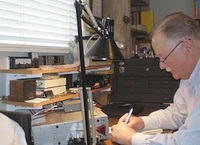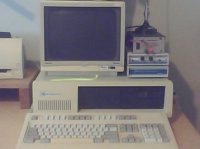KB6NN
Name: Howard Lang
Call: KB6NN
QTH: Eureka, California
Grid: CN70ws

Home About Photos Log Contact Digital
When the hobby first bit:
My first knowledge of Ham Radio came when I told my father I wanted
to listen to short wave. I had been enjoying a hobby of working with
audio gear for a number of years, and had bought a Radio Amateur's
Handbook because it had tube diagrams in the back. One of my father's friends was a ham, so my dad asked him
to show me his gear and recommend a receiver. My first receiver was a
used Hallicrafters SX-111. I listened for hours and dreamed of becoming a
ham. But life, as it sometimes does, got in the way.
Joined the ARRL before I was licensed:
Some years later (1975), I had joined the ARRL and had accumulated
a
number of books, including Hints and Kinks for the Radio Amateur. I
built a simple direct
conversion receiver from scratch, from a schematic I found, and
parts from an electronic surplus shop. I wanted to listen to ham
radio while I was away at school. I copied
the W1AW code practice broadcasts, and did some qualifying runs.
Got my certificates up to over 10wpm. I was ready for
my test, which required sending and receiving code at 5wpm.
I didn't take that test until three years later.
(back to top)
Home Sweet Home:
When
I settled in Humboldt County in the fall of 1977, I listened to the 80 meter band
on the receiver I had built, and heard a loud local CW signal. I tracked the guy down, and he
invited me to my first meeting of the Humboldt Amateur Radio Club, which
met at the OES headquarters in the basement of the Humboldt
County Courthouse in Eureka.
Elmers abound:
At the ham club meeting, I met several friendly Elmers, who helped
me get
my first license, which at the time was the entry level Novice class,
and my call sign, KA6AAZ, in May of 1978. Again through
the club, I took courses, jumped over General to Advanced, and got my
current call sign, KB6NN, in May of 1979. I eventually made Extra in
July of 1991, in an informal competition with a school classmate of
mine who lived in Southern California.
(back to top)
My favorite things:
Besides the time I spent as a novice working CW, which I still
consider my best of times in ham radio, my most enjoyable ham radio
things have been the various Field Day and field operations I have
participated in. This would also have to include a receive-only
adventure in the Great Smokey Mountains in the summer of 1977. The
little direct conversion receiver I had built was running on battery
power at the
campsite. The band was active that day during the downpour -
unforgettable.
Ham hiatus:
Life got in the way of ham radio, and I put my ham gear away. I
made a few attempts to get on the air again, but was off the air for
more than a decade in total. I resumed operation in the summer of 2007.
What got me back in? Field Day, of course.
(back to top)
All that noise on the bands:
Back in the groove again in 2007, I was surprised at how much noise
was on the bands all the time. As a novice, I had been used to
after dark operating HF, since there was less man-made noise. But now, it was
the opposite. A "broad band white noise" (from consumer electronics:
computers, televisions, etc.) now runs S-7 to S-9 or more, reaching a
peak starting about 5 or 6 PM local time, and continuing into the
night. It's almost all the day and night on weekends. So the most
quiet time in radio at my QTH was weekdays while people are at work.
Power outage takes away noise:
Once during that time, an earthquake took out all the power in our
area. Before cleaning up, the first thing I did when I got home
was turn on the HF rig. Quiet like the old days! In the weeks afterward, I started
going out away from home with a battery operated radio and found that
the farther away from town I got, the less noise there was on the bands. More adventure,
because there was now an even better reason to go portable or
mobile.
(back to top)

The Packet Setup in the photo above
is the rig I had running in the so-called golden age of packet in the
1980's and 90's before the internet took off. I recently took it out of
storage and got it working again. What surprised me was how slow data
traveled in those days. Also a surprise was how reliable it is, and how
much fun. To the right of the monitor is the packet rig. The mag
mount antenna is on the power supply. Beneath the power supply, the
Kantronics DVR 2-2 dedicated packet VHF transceiver (crystal
controlled, low current draw, great for solar installations). Beneath
that, the TNC, a Kantronics KPC-2. The computer is a home-built IBM-PC
XT clone (got the parts from JDR Microdevices), with a megabyte of memory (yes, a whole megayte), a 20Mb hard
drive (yes, a whole 20Mb), and a 5.25" floppy disk drive. Yep. And how magically fast
it seemed in those days!
These
days, packet and other digital modes can be done without a hardware
Terminal
Node Controller (TNC). Instead, software does the work and the
computer's sound card or an external sound card creates the tones that
go to the radio. You still need to have a way to get tones to and
from the radio. You can use acoustic coupling, but copy is better
if you use a wired connection. Used to be, one could go to the
neighborhood electronics store and buy a few parts to do the job.
There might be some parts stores in a large population area, but
not any more in smaller cities and towns. If you are interested
in making a wired interface, just using 1/8-inch phone plugs won't do
it. The levels will be too high and distorted. Breadboard
something with back to back audio transformers and some trim pots so
you don't overload the radio or the computer audio input stages.
Many designs available in print and on the internet.
External sound cards that do minimal duty are found at low
prices. A decent external sound card designed for ham radio will
cost you more.
(back to top)
See you on the bands.
73,
Howard Lang, KB6NN
QTH:
Eureka, California
Grid: CN70ws
Eureka is located in the middle of Humboldt County, California.
Humboldt County is in Northern California, on the coast, about 80 miles
south of the Oregon border.
Howard's
Amateur Radio Memberships:
Humboldt
Amateur Radio Club
Far
West Repeater Association
Ten-Ten
International (#25696)
American
Radio Relay League
(back to top)
Content and photos copyrighted. © All rights reserved.
Hosted by humsites.com.


